Within the diverse landscapes of North Carolina reside 12 unique lizard species. From the arrival of spring until the fall, these reptiles are most active, with each species displaying its own preference for activity timings and habitats.
This comprehensive guide delves into the world of lizards in North Carolina, providing crucial information such as their appearance, behavior, and distribution within the state. North Carolina’s varied habitats, including woodlands, mountains, grasslands, and even urban areas, host these intriguing creatures.
Whether you’re an avid herpetologist seeking lizards in the wild, or simply curious about the types residing in North Carolina, this article promises to be insightful. With lizards representing one of the most diverse reptile groups, there’s a wealth of intriguing knowledge to uncover about these fascinating creatures.
Table of Contents
Lizards in North Carolina
Anguidae
1. Eastern Glass Lizard
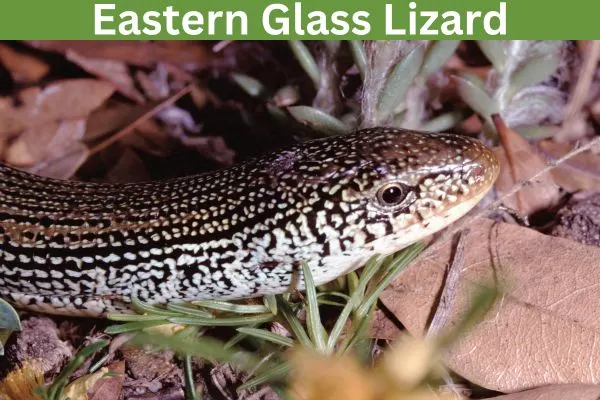
- Experience Level: Intermediate
- Family: Anguidae
- Scientific Name: Ophisaurus ventralis
- Other Names: n/a
- Adult Size: 18 to 43 in. (46 to 108 cm.)
- Lifespan: 10 to 30 years
- Average Price Range: $50
The eastern glass lizard is one of the few glass lizards that live in North Carolina. This species of lizard is native to the southeastern United States. Eastern glass lizards in North Carolina can be found in the eastern part of the state. This lizard lives in the Coastal Plains and can be found in flat woods, and wetland habitats.
Eastern glass lizards have a snake body, with tan, olive, or yellowish coloring. This lizard has earholes, and moveable eyelids, which can help distinguish them from snakes. They have a dark mottled pattern and stripes on their body.
Despite looking like a snake, this lizard is harmless and does not have fangs. They cannot open their jaw wide and only eat food that fits into their mouth. Eastern glass lizards live in sandy habitats, and they prefer to burrow. They have a secretive nature and are not seen often. This species hunts for small invertebrates, spiders, nad young rodents, and may be seen during the day.
2. Slender Glass Lizard
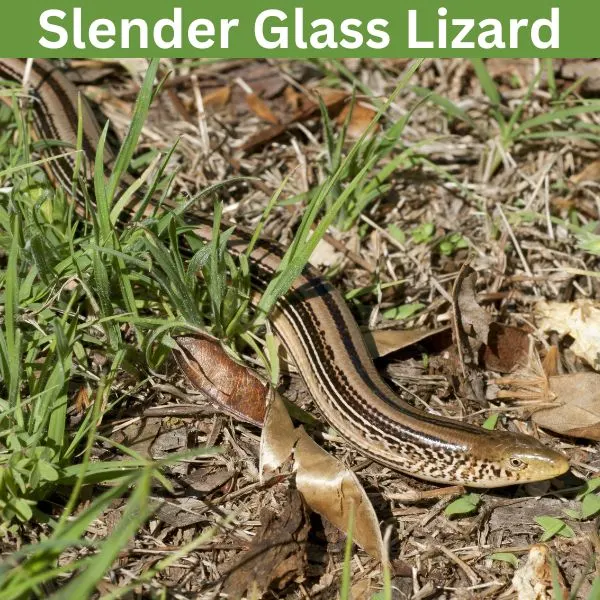
- Experience Level: Intermediate
- Family: Anguidae
- Scientific Name: Ophisaurus attenuatus
- Other Names: n/a
- Adult Size: 22 to 46 in. (55.88 to 116.84 cm.)
- Lifespan: 10 to 30 years
- Average Price Range: $50
The slender glass lizard has a large range covering the southern United States. This lizard is found in most of North Carolina but is absent from the western portion of the state. Active during the day, this lizard lives in burrows, making them in sandy areas. Slender glass lizards prefer dry habitats and are common in fields, and sandhills. Due to their secretive nature, this lizard is not seen often.
Slender glass lizards are one of the longest lizards in North Carolina and actually look more similar to snakes. This species has six stripes running down their body, and may have white specks on their body. Slender glass lizards do not have belly plates, which is why they cannot move across smooth surfaces like snakes.
Insects, spiders, and small rodents are some of the prey this lizard eats. They breed in the spring and lay up to 15 eggs in the summer. This lizard is able to break off its tail, but also swim to defend itself from predators like birds, or skunks. Slender glass lizards have a stable overall but have become rare in some places due to the destruciton of their habitat.
3. Mimic Glass Lizard
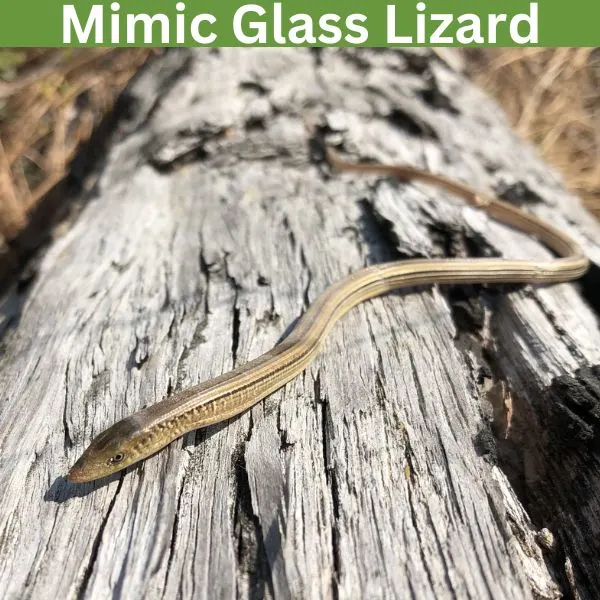
- Experience Level: Intermediate
- Family: Anguidae
- Scientific Name: Ophisaurus mimicus
- Other Names: n/a
- Adult Size: 15 to 26 in. ( 38 to 66 cm.)
- Lifespan: 10 to 30 years
- Average Price Range: $50
Mimic glass lizards have a very small range, and are only found in the coastal regions of the southeastern United States. In North Carolina, this lizard’s range covers mainly the southeastern coastal plains region. Mimic glass lizards live in open habitats, and may hide under debris like logs, or in thick vegetation.
This lizard has brown, black, to tan coloring. They have 3 or 4 stripes that run down their body, and white spots may sometimes appear on their head. This lizard is smaller and has a more slender appearance when compared with other glass lizards in North Carolina.
Slender glass lizards feed on insects, spiders, and other invertebrates they find. Unlike snakes, this lizard is not able to flex their jaws wide and does not have fangs. This lizard will lose its tail if grabbed, and threatened. They will regrow their tail over time, but they will not grow back fully.
Dactyloidae
4. Green Anole
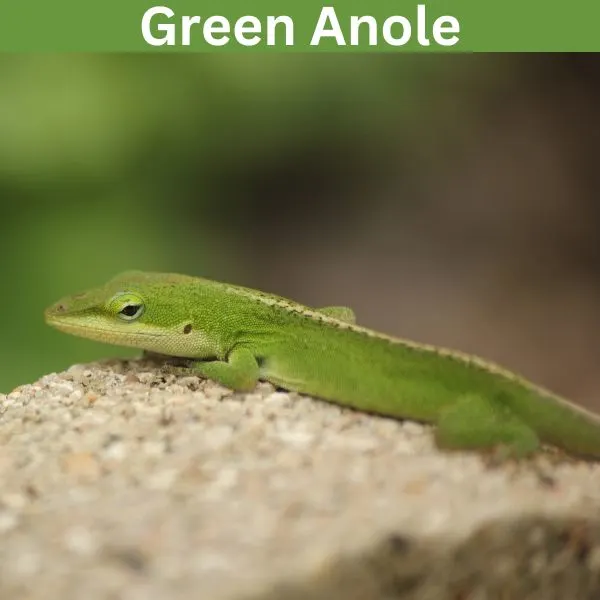
- Experience Level: Beginner
- Family: Dactyloidae
- Scientific Name: Anolis carolinensis
- Other Names: American anole, Red-throated anole
- Adult Size: 5 to 8 in. (12.7 to 20.32 cm.)
- Lifespan: 5 to 8 years
- Average Price Range: $10
The green anole is found in the coastal plains region of southern North Carolina. This species lives in urban areas, wetlands, and woodland habitats. Green anoles are active during the day and enjoy climbing on trees, or buildings.
Green anoles are native to the southeastern United States, and unlike in other states, they do not have any competition from invasive anoles currently in North Carolina.
Green anoles are named after their vibrant green coloring but are able to change their shade to help them better blend into their environments. These lizards are medium-sized, with pointed heads. Green to brown is what the colors these lizards can change from.
Males are typically larger than females but can be more aggressive. Males have a dewlap under their neck, which turn reddish during the breeding season.
Green anoles are territorial and will fight with each other in the breeding season for the right to mate. Insects, spiders, and even plant material is what this species eats. They face predators like larger lizards, birds, and parasitic flies in the wild.
Teiidae
5. Six-lined Racerunner
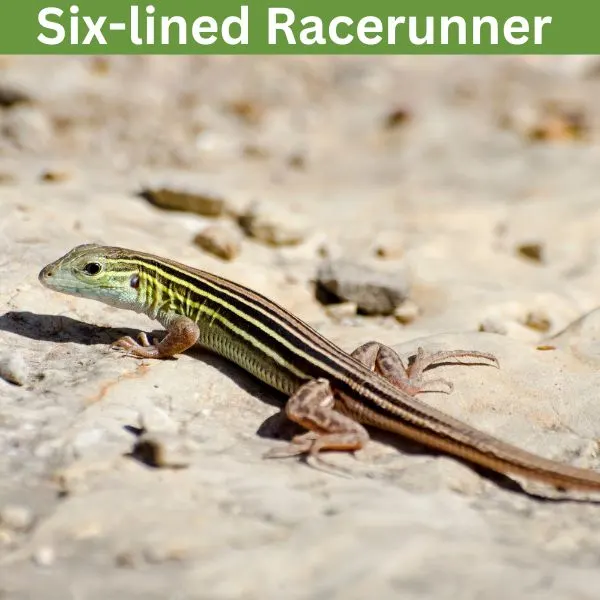
- Experience Level: Intermediate
- Family: Teiidae
- Scientific Name: Aspidoscelis sexlineata
- Other Names: Sandlapper lizard
- Adult Size: 6 to 9.5 in. (15 to 24 cm.)
- Lifespan: 4 to 5 years
- Average Price Range: $30
The six-lined race runner is found throughout North Carolina, and this lizard is native to the southern United States. Mountains, woodlands, and Coastal Plains are where this lizard lives. They are a terrestrial species, and are able to tolerate high temperatures. This species is active in the day, and at night, and in winter they rest in a burrow.
Six-lined race runners are named after the six yellowish, or white lines that run down their bodies. This species has tan, to olive coloring. They have velvety skin, and when born have a blue tail that will fade with age.
Lower elevations with sandy soil is where this species prefers to live. They breed in the spring, and lay their eggs in the summer. Six-lined race runners lay up to 6 eggs, and may lay more after their first clutch hatches.
Insects make up the majority of this lizard’s diet, but they also feed on spiders. Red ants that are invasive are one of this lizards predators, but they also get eaten by birds, and small mammals.
Scincidae
6. Little Brown Skink
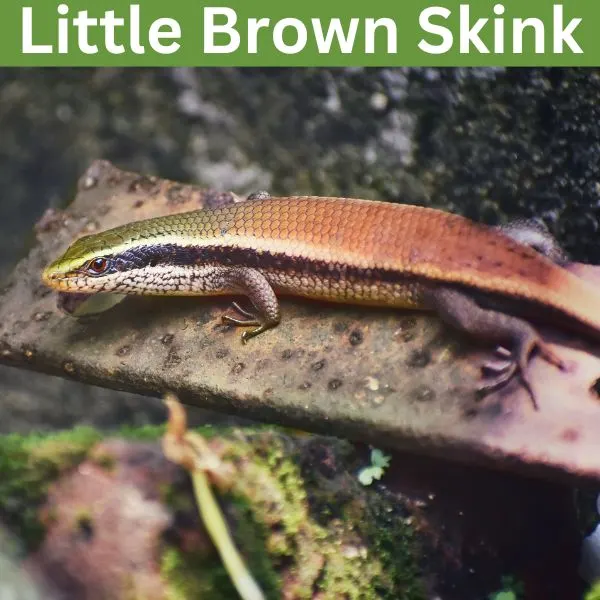
- Experience Level: Beginner
- Family: Scincidae
- Scientific Name: Scincella lateralis
- Other Names: Ground Skink, Brown-backed Skink
- Adult Size: 3 to 5.25 in. (7.62 to 13.3 cm.)
- Lifespan: 2.5 years
- Average Price Range: $5
Little brown skinks are native to the southeastern United States, and are found all across North Carolina. This species lives in woodlands and forest habitats near freshwater sources like rivers. Little brown skinks live in leaf litter, and require loose soil, since they are fossorial.
This species is named after their brown coloring, and have a dark stripe on their sides. They have a coppery brown coloring, with white and yellow markings on them. Specks may appear on them. Their limbs are very small, and their bodies are slender. This species is one of the smallest lizards not only in North Carolina but also in North America.
Little brown skinks are active during the day and can be seen most of the year except for when hibernating in the winter. Small insects and spiders are what this lizard eats, and their track their prey by flicking their tongue, and sensing their prey. Predatory birds like owls, snakes, and larger lizards are what prey on this lizard.
7. Five-lined Skink
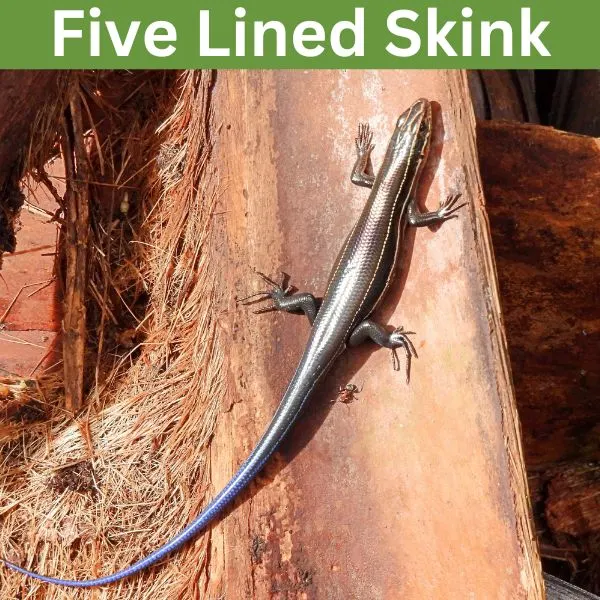
- Experience Level: Intermediate
- Family: Scincidae
- Scientific Name: Plestiodon fasciatus
- Other Names: American Skink
- Adult Size: 4.9 to 8.5 in. (12.5 to 21.5 cm)
- Lifespan: 6 years
- Average Price Range: $12
The five-lined skink is native to the southeastern United States. This species is found across North Carolina and lives in woodlands and forest habitats near freshwater sources. Five-lined skinks are secretive and may hide under rocks, and other debris like logs.
Five-lined skinks are a small to medium-sized species, with tan, olive, or black coloring. They are named after the five lines that run down their body, and when born have a blue coloring on their tail. In the breeding season, males have red coloring on their faces, and males are also slightly larger than females.
Spiders, crickets, and other invertebrates are what this lizard eats. They are sometimes kept as pets and are easy to keep, and can live for up to a decade if properly cared for.
8. Broad-headed Skink

- Experience Level: Intermediate
- Family: Scincidae
- Scientific Name: Plestiodon laticeps
- Other Names: Broadhead Skink, Red-headed Scorpion
- Adult Size: 5.9 to 13 in. (15 to 33 cm.)
- Lifespan: 4 to 8 years
- Average Price Range: n/a
Broad-headed skinks are native to the southeastern United States, and live across North Carolina. This lizard lives in oak wood habitats and is semi-arboreal. Broad-headed skinks hunt during the day and may use trees to sleep in, or find prey.
These skinks are some of the largest lizards in North Carolina and are named after their large heads. They have a tan, to olive coloring, with an orangish shade on their heads. This species when born has stripes, and a blue tail, which fade to a solid color with age.
Broad-headed skinks are harmless lizards, though some may think they are venomous due to their bright colors. If approached this species will flee and can drop its tail to help them escape. Broad-headed skinks mate in the spring and lay up to 22 eggs. Their eggs are laid in a moist area like a log, and hatch in the summer.
9. Southeastern Five-lined Skink
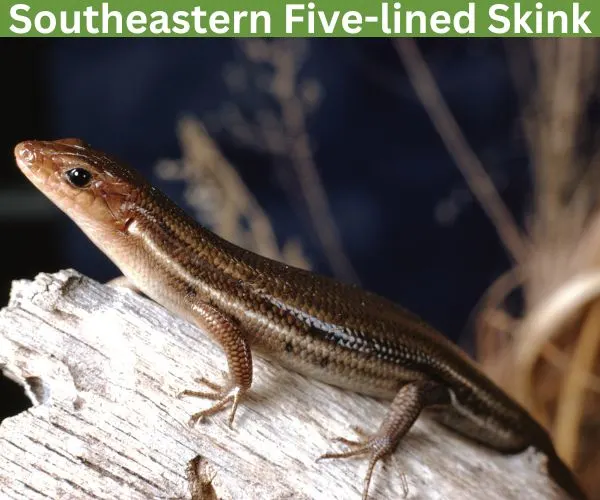
- Experience Level: Beginner
- Family: Scincidae
- Scientific Name: Plestiodon inexpectatus
- Other Names: n/a
- Adult Size: 5.5 to 8.5 in. (13.97 to 21.59 cm.)
- Lifespan: 6 years
- Average Price Range: n/a
The southeastern five-lined skink is native to the southeastern United States. This lizard lives in dry, and wooded habitats with lots of natural debris. They are found all across North Carolina and have a stable population. The southeastern five-lined skink is active during the day and is a terrestrial species, that is able to live in even dry conditions, with little vegetation.
Southeastern five-lined have five yellowish stripes that run down their body, which may become lighter with age. This lizard has tan or olive coloring. They have robust bodies, with long tails.
Grasshoppers and other large insect prey are what this species prefers to eat. They are sometimes kept as pets and have a stable population across their range. This lizard mates in the spring and lays up to 12 eggs.
10. Coal Skink
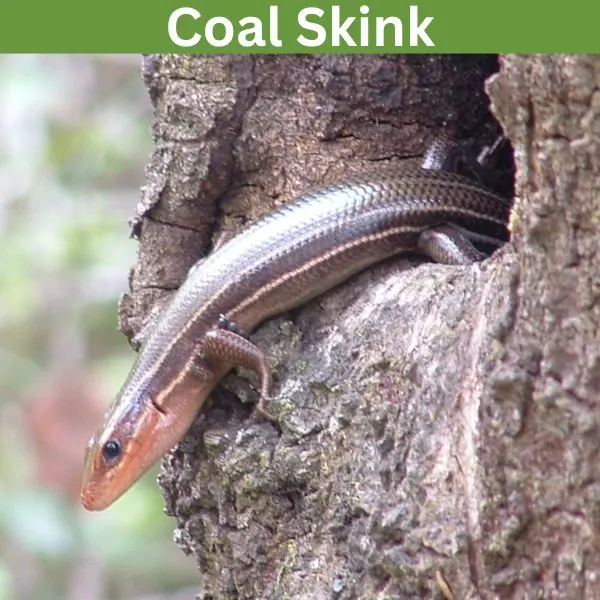
- Experience Level: Intermediate
- Family: Scincidae
- Scientific Name: Plestiodon anthracinus
- Other Names: n/a
- Adult Size: 5.1 to 7.1 in. (13 to 18 cm.)
- Lifespan: 6 years
- Average Price Range: n/a
Coal skinks have a scattered range across the eastern United States. This lizard is found in a small range within the northwestern corner of North Carolina. This lizard lives in moist woodland habitats. They are found under rocks, ands logs near the edges of streams.
Coal skinks are a medium-sized species, with a slender body, and small legs. They have a black to grayish coloring, with white or yellowish stripes running down their sides. Coal skinks that are male in the breeding season may have a reddish coloring on their face.
The spring and summer is when coal skinks lay their eggs, and they have around 8 to 9 eggs in a clutch. This lizard has a stable population but is rare to find due to their small range.
Phrynosomatidae
11. Eastern Fence Lizard
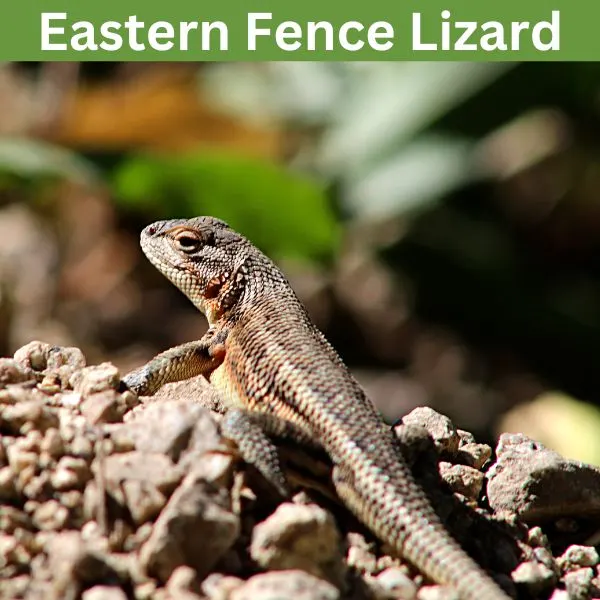
- Experience Level: Intermediate
- Family: Phrynosomatidae
- Scientific Name: Sceloporus undulatus
- Other Names: Prairie lizard, fence swift, pine lizard, gray lizard
- Adult Size: 4 to 7.25 in. (10.16 to 18.41 cm.)
- Lifespan: 4 years
- Average Price Range: $20
The eastern fence lizard is found in the eastern United States. This species is native to North Carolina, and live in habitats like grasslands, shrublands, urban areas, and woodlands. Eastern fence lizards are active in the day and enjoy climbing on things like fences, or tree stumps.
This lizard has keeled scales, with tan, to black coloring. They have a chevron pattern on their back, and males have blue coloring on their bellies and neck. Eastern fence lizards are medium-sized and have a coloring that helps them blend into trees.
Eastern fence lizards feed on insects, spiders, and other small invertebrates they find. They are one of the most common lizards in North Carolina and have a stable population overall.
12. Texas Horned Lizard
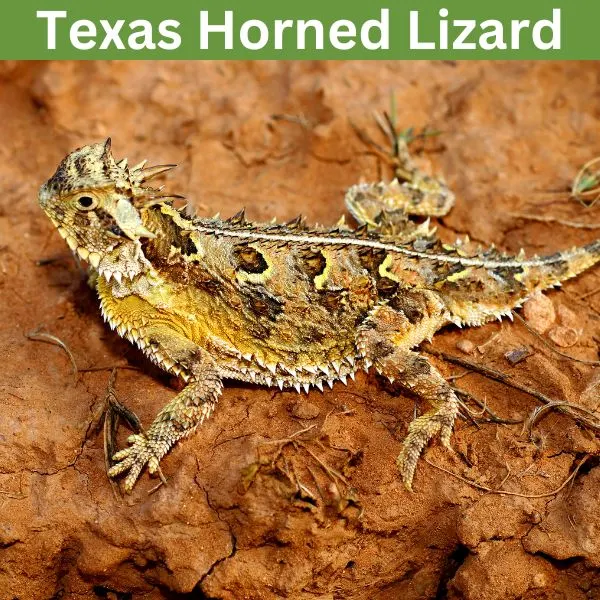
- Experience Level: Advanced
- Family: Phrynosomatidae
- Scientific Name: Phrynosoma cornutum
- Other Names: Horny Toad
- Adult Size: 3.7 to 5 in. (9.93 to 12.7 cm.)
- Lifespan: 5 years
- Average Price Range: $40
The Texas horned lizard is a spikey reptilian native to the western United States. This species has been introduced to North Carolina and was likely introduced to the region by the pet trade. Sandy habitat with sand dunes is where this lizard lives, and they inhabit the Coastal Plains in the state.
Texas horned lizards have tan, gray, brown, or reddish-brown coloring. They have spikes covering their body, and sides and large ones on their head. This lizard has an oval shped, and falt body. They have dark blotches covering them and are one of the most unique looking lizards living in North Carolna.
The body and spikes of the Texas horned lizard helps them not get eaten by predators. This lizard’s appearance also helps them camouflage into their environment. They feed on small insects, and have predators like birds, dogs, and cats. To ward off canine predators this lizard may squirt blood from their eyes at their attacker.
Gekkonidae
13. Mediterranean House Gecko
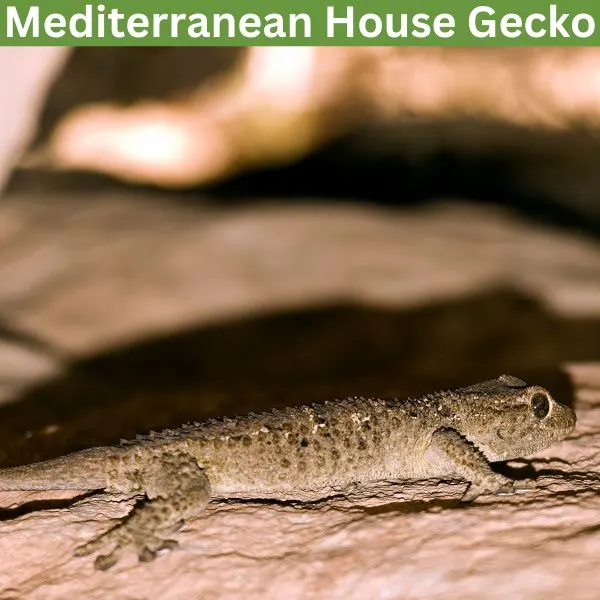
- Experience Level: Beginner
- Family: Gekkonidae
- Scientific Name: Hemidactylus turcicus
- Other Names: Turkish gecko
- Adult Size: 3 to 6 in. (7.62 to 15.24 cm.)
- Lifespan: 9 years
- Average Price Range: $10
The Mediterranean house gecko is an invasive species found in North Carolina, and is native to the Mediterranean region. This lizard lives in urban areas and is active at night. They may hide in attics, and take shelter under debris.
Mediterranean house geckos are a small species and have sticky toe pads to help them climb. This species is tan, cream-colored, and has very granular skin. They have a mottled pattern covering them, and large yellow eyes with an elliptical pupil, which help them see in the dark.
These lizards mainly feed on insects, and hunt for them where they are common like places with man-made light sources. Mediterranean house geckos use calls to attract mates, which sound high pitch like a bird. This lizard is believed to have come into the state through the pet trade.
Questions About Lizards in North Carolina
Are there invasive lizards in North Carolina?
The Mediterranean house gecko is one invasive lizards that you may find in North Carolina. Originating from the Mediterranean, this species is thought to have come to the United States by traveling on cargo ships. Texas horned lizards are another species that have been introduced to North Carolina.
In North Carolina what is the largest lizard?
Glass lizards are the largest types of lizards that live in North Carolina but may not be seen often because of their secretive nature. Glass lizards resemble snakes, and have no limbs, and thick bodies. Slender glass lizards are the largest lizards in North Carolina. Broad-head skinks are the largest lizards in North Carolina that have legs and can reach over a foot in length.
Are there dangerous lizards in North Carolina?
The lizards that inhabit North Carolina are all relatively harmless and are not toxic, or venomous. While some lizards may bite in self defense, their bites are not typically dangerous due to their size. The germs on a lizard are their most dangerous features, and you should wash your hands after handling a lizard to prevent illness.
Wrapping up
Lizards are an important part of North Carolina’s ecosystems, and help maintain balance in the state. Lizards can be predators or prey and interact with North Carolina’s species of other reptiles, mammals, insects, and birds. Maintaining a healthy ecosystem will not only protect lizards, but the countless wildlife that call the state it’s home.
It is not uncommon for reptile lovers to keep a lizard as pets, and some of the species in North Carolina can make a good reptile companion. Knowing your species is very important, as some lizards may not do well in captivity.
Trying to keep a wild lizard as a pet is not recommended, since their lifespans are typically shorter, and they are more prone to diseases and parasites. Taking a lizard from the wild can also affect their population, and some are even endangered. Learning about the various lizards in North Carolina not only shows the interesting animals that call the state its home, but also makes it easier to protect, and maintain the amazing wilderness.
Other lizards in nearby states
